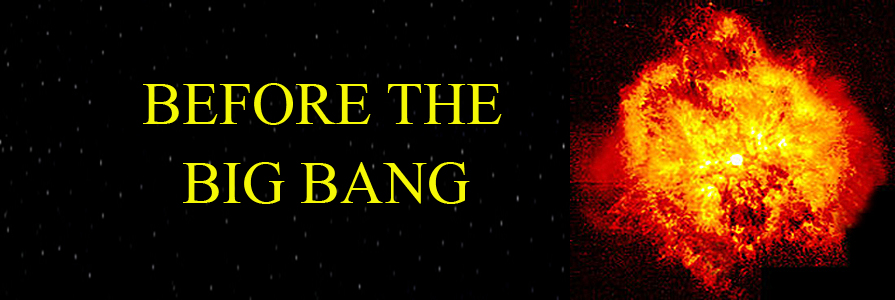
Background: Before The Big Bang
Until recently, asking what happened before the Big Bang was generally considered by physicists to be a religious question. General Relativity Theory just does not go there. As time goes to zero, General Relativity spews out zeros and infinities. So the question did not make sense from a mathematical/scientific point of view.
Thanks to studies on the rate the universe is expanding, and applying this knowledge in reverse, we now know the universe is roughly 13.8 billion years old. Everything we can observe in our solar system, other galaxies and everything in between, Big Bang Theory says inflated out extremely rapidly from an initial point much smaller than an atom. The Big Bang Model is currently our best explanation for why the cosmos appears as it does. However, the Big Bang Model is not able to answer some of the more challenging questions, including - what preceded it and what caused it.
If we imagine reversing the expansion of the universe in time, all the galaxies, etc. would converge to a single infinitesimally small point - the Big Bang Singularity. At this point, our current theory of gravity, Einstein’s General Theory of Relativity, predicts that the universe had an infinitely small volume, and an infinite density and temperature. This moment is often referred to as the beginning of the universe - the birth of matter, space and time. Such an interpretation, however, goes much too far. The infinite values indicate that General Relativity itself is broken. The laws of physics no longer apply. To explain what happened before and during the Big Bang, physicists must go beyond General Relativity. Top
Before The Big Bang Possibilities
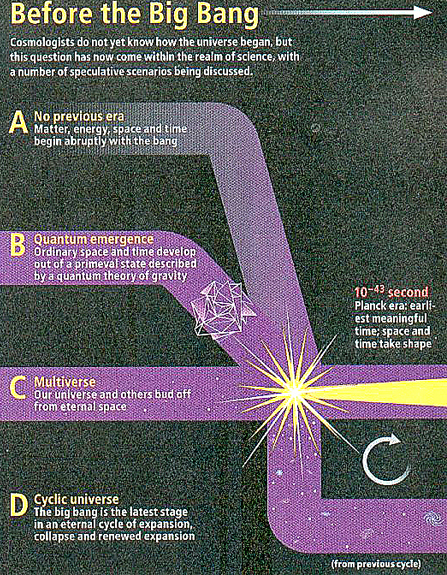
First of all, the language we use to describe what we know and don’t know can sometimes be very murky For instance, the universe may be defined as all that exists in a physical sense. But... we can only observe part of that. No scientist thinks that the Observable Universe is all there is. Most estimates predict that the full universe is at least 1,000 times larger than the Observable Universe.
Galaxies in every direction seem similar to each other, that is, there is no special direction in space. This means that the universe does not seem to have an edge or a center. In other words, if we were to instantaneously relocate to a galaxy far, far away, we would see a cosmos very similar to the one we observe from earth. It would have an effective radius of 47 billion light-years (the Observable Universe). We could not see beyond this radius wherever we were located.
In scientific terminology this is called the Cosmological Principle - the idea that the universe is "everywhere homogeneous and isotropic". Homogeneous means uniform or evenly distributed. Isotropic means it looks the same in all directions , i.e. there are no large clumps or voids in any direction. (Authors comment - Some parts of the visible universe do have some extremely large voids and clumps of galaxies - see the Cosmic Web Page. However these anomalies are universally ignored because the mathematics of the universe becomes so complex that they are not solvable by scientists and mathematicians in our generation.)
The diagram at the left outlines four options that may have preceded the Big Bang (there could be more):
-
There is no previous era - this is the religious scenario. Matter, energy and time begin instantaneously by some as yet unknown external (to our universe) force. Could there be a super powerful God who decided to create a universe all at once?
-
Quantum Emergence - In the miniscule quantum universe, the lowest energy state, the quantum vacuum is not totally empty. Even if the total energy of a quantum vacuum system is zero, it is never "really zero" due to constant quantum particle fluctuations. If one of these fluctuations is unstable, it may grow extremely large like a soap bubble that blows itself up. Our universe might have been formed by one of these huge fluctuations of positive energy which was offset by an equal amount of gravity. Steven Hawking has been quoted as saying rather off-handedly "the universe came out of quantum nothingness".
-
Multiverse -The original idea was that in the beginning there was no one "big bang". There was just "eternal inflation" going on, setting off an endless series of bangs that created many individual universes. Our universe is just one of these many universes. The theory holds that new universes (known as “pocket universes”) are constantly being created, but they cannot be seen from our universe. New universes are being created over and over again, sometimes with similar physical laws to us, other times with vastly different physical laws. Some of these universes collapse within seconds after forming. Today, there are quite a few versions of the multiverse being circulated. If conditions are suitable, matter can coalesce into galaxies and planets similar to those in our universe. If..., the right elements are present, intelligent life could also evolve in these other worlds.
-
Loop Quantum Gravity (LQG) - One approach to merging quantum theory and gravity (a goal of modern physics) suggests that it is not just gravity but space-time itself that is quantized, woven from tiny, individual loops that cannot be subdivided any further. The loops in the "loop quantum gravity" scenario are so tiny that to a human observer, space-time looks smooth and continuous. As you go back in time in an LQG universe, you reach the Big Bang, but there is no singularity. Instead, you cross a “quantum bridge” (sometimes called a wormhole) into another older universe. This is called the Big Bounce Theory. The Big Bounce Theory is a scientific model that claims all universes start and end in cycles. Every big bang is the result of the collapse of a previous universe, i.e. a Big Bounce from one universe to the next.
Lets take a look at the last three scenarios in some detail. Top
Quantum Emergence
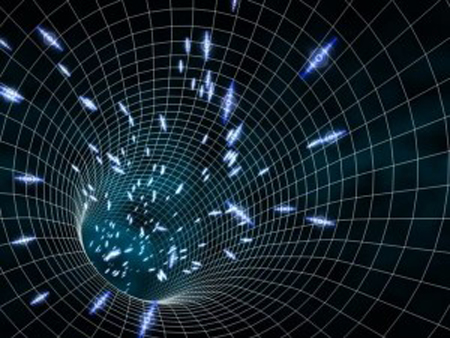
In the quantum universe, the lowest energy state, the quantum vacuum (the scientific version of nothing), is not empty. The total energy of a quantum vacuum system is never absolute zero due to the constant quantum fluctuations of "virtual particles". These quantum jitters are the sudden appearance of dual particle pairs, such as electrons and positrons, that almost instantaneously annihilate each other and disappear.
So a hydrogen atom is not simply an atom with a proton at its center and an electron orbiting around it. The hydrogen atom also contains additional fluctuating virtual pairs of electrons and positrons. In 1947 referencing famed British Physicist Paul Dirac's quantum mechanics equations, American scientists measured the hydrogen spectrum, including the virtual particles, to an accuracy of one part in a billion. The data compared exactly to Dirac's equations predictions. This fantastic measurement brought quantum mechanics and virtual particles out of theory and into the real world.
Vacuum fluctuations amount to changes in the value of the vacuum energy, now called dark energy. If one of these fluctuations is volatile, it may grow extremely large and create a new universe. The total energy still remains zero on average because the positive energy of matter and the negative energy of gravity cancel out (assuming our universe is mathematically flat, which is true to plus or minus 0.5% - as tight as we can measure it).
Quantum mechanics allows all possible outcomes in any given scenario. A prediction is the result of summing up all the possibilities, with the final answer being the outcome with the highest probability. However, there is a finite probability of other outcomes. Applying this logic to the quantum vacuum of space (the scientific equivalent of nothing), if universes are popping in and out just like virtual particle fluctuations, there is a finite probability of a universe such as ours emerging. And, if that emerging universe happened to be undergoing inflation, it could last a very long time instead of disappearing. Behold - a new universe was just born!
Quantum Emergence is a speculative theory that the universe evolved spontaneously from a random fluctuation in a quantum vacuum. However, the quantum vacuum was a very loaded "nothing" because it already contained the whole machinery of quantum field theory - the modern description of how very elementary particles of matter interact with one another. Top
Multiple Universes - The Multiverse
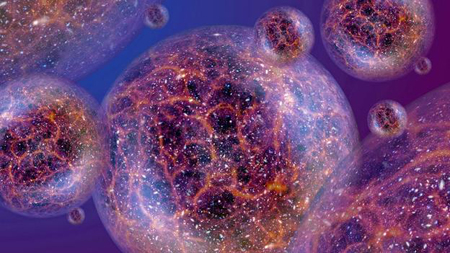
To talk about multiple universes, lets define what a universe is and what we mean by multiple universes. A generally accepted definition of a universe is the total amount of matter, energy, time, and space that is all interacting and subject to the same fundamental physical laws. Anything that does not interact and conforms to different laws would be “outside” our universe (but “inside” its own universe).
Within our universe there is a limit to what we can ever "see" due to the distance light can travel in 13.8 million years. Therefore we can look in any direction and see for about 47 billion light years - this is our Observable Universe. Although we can not see beyond 47 billion light years, we assume that the balance of our universe obeys the same physical laws we observe.
Alan Guth, Professor at MIT, was the original founder of Inflation Theory in 1980 and coined the term "Inflation". Guth was really trying to explain the Bang part of the Big Bang, not any events before the Big Bang. Andrei Linde, contemporary to Guth as a Professor at Stanford, subsequently expanded Guth's original equations and discovered that inflation was "eternal". He found that some quantum fluctuations during inflation are so large that they continuously produce rapidly expanding new universes. This activity makes the process immortal and transforms a single universe into a multiverse.
It has since been discovered that almost all mathematical models of inflation are inherently eternal. Andre Linde has explained that "It is possible to invent models of inflation that do not allow a multiverse, but it is difficult". Therefore, if one accepts the inclusion of inflation in the Big Bang, one is almost obligated to accept "eternal inflation" and the "multiverse" as an acceptable part of a total universe theory. However, not all scientists are intellectually ready and willing to accept this scenario.
If eternal inflation is correct, then the Big Bang is probably the origin of our universe, but not the beginning of all universes, which would have begun much earlier. In other words, eternal inflation could answer the question of what preceded the Big Bang, but it will still leave the question of "the ultimate multiverse origin" out of reach. Top
Evidence Of A Multiverse?
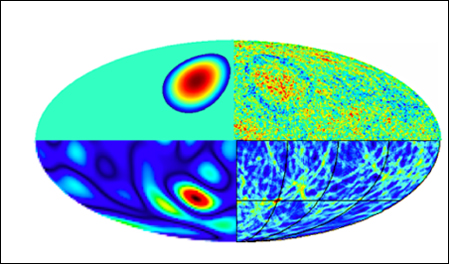
Is it possible to test the multiverse theory some how? Surprisingly, observational tests of the multiverse scenario may in fact be possible. Several cosmologists have pointed out that an early collision of our expanding bubble with another bubble in the multiverse would produce a bruised imprint in the cosmic microwave background (CMB) radiation. The detection of such a spot would provide evidence for the existence of another bubble universe.
These bubble universes probably had a violent beginning, bouncing around and leaving “cosmic bruises” where they touched. Stephen Feeney and company at University College London say they have found tentative evidence of such bruising in the form of circular patterns in the CMB. In fact, they have found four such bruises, implying that our universe must have collided at least four times in the past.
A collision, like the one in the illustration at the upper left above, would leave a pattern in the CMB similar to the one at the upper right. As Feeney readily acknowledges: “it is rather easy to find all sorts of statistically unlikely properties in a large data set like the CMB.” The only way to settle this issue will be to confirm or refute the findings with better data. New data should be forthcoming thanks to the European Planck spacecraft. Top
String Theory Multiverse
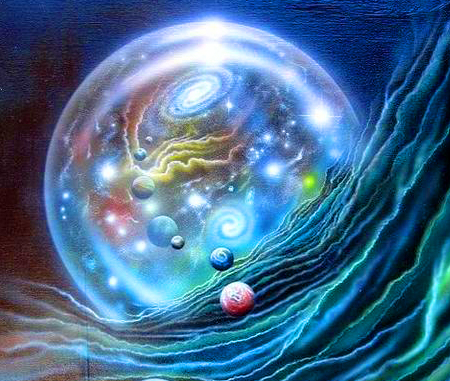
The basic idea behind String Theory is that all of the different fundamental particles of the Standard Model are really just different versions of one very basic object: - a vibrating oscillating string. The strength of String Theory is that it accounts for all four known forces in one elegant theory. But it should also be noted that to date there is no experimental evidence that string theory is the "basic description of nature".
The most modern version of string theory, M-Theory in which there are 11 dimensions, is an extension of the original string theory. M-Theory incorporates membranes into the string theory picture. A membrane, or brane or P-brane, is a multi-dimensional medium where the variable P refers to the number of spatial dimensions of a brane. For example, a zero-brane is a zero-dimensional point-like particle, a 1-brane is a string that can either be open or closed, a 2-brane is a 2 dimensional "membrane" like a large tablecloth, etc.
A strings length is controlled by its energy. If a string has enough energy, it can be quite large. A large 1-brane might look like an infinitely long telephone wire. A large 2-brane might look like a humongous table cloth stretching indefinitely in two directions. A 3-brane could be an incredibly large box.
We tend to think of a 3-brane box as one that does not include us or the rest of the universe. But what if the box was so big that our whole universe was inside the box. We would be wandering around in the 3-brane just like fish wander around in the ocean. What if there were other "boxes" nearby to our box? Lisa Randall, a Harvard Physicist, has suggested that one of the reasons that gravity may be so weak in our world is that it is primarily located in another close-by brane and "leaks" over into our world.
The basic idea of a "string theory multiverse" is that in the beginning there really was no one Big Bang. There was just "eternal inflation" going on, setting off an endless series of bangs that created many individual universes. Our universe is just one of these many universes. Elements of our world might interact very weakly, or not at all with other worlds. Each world would develop separately from each other and might even have different laws of physics. It turns out that almost all mathematical models of "early inflation" allow for multiple "pocket universes" to develop. One has to severely restrict the models in order to obtain just a single universe.
String theory is an elegant mathematical theory that has expanded the thinking of physicists in a number of different ways (supersymmetry, multiple dimensions, big bang origin, etc.). It has also brought very sophisticated mathematics to the physics world and made many physicists into very respected mathematicians. It might ultimately be "the theory" that correctly explains the mysteries of nature. Unfortunately, there is a major gulf between the super-micro world of strings plus the macro-world of branes and any human observations that can confirm string theory.
For more detailed string explanations, visit the String Theory Page. Top
A New Theory - Many Interacting Worlds (MIW)

In a paper published in October, 2014 in the prestigious journal Physical Review, Professor Howard Wiseman and Dr Michael Hall from Griffith's Centre for Quantum Dynamics in Australia, and Dr Dirk-Andre Deckert from the University of California, proposed that Many Interacting Worlds (MIW) are real. Rather than evolving completely independently of one another, nearby worlds interact with each other by way of a subtle repulsive force.
Professor Wiseman and his colleagues propose that:
-
Rather than multiple island universes as proposed by other multiverse theories, MIW suggests that "classical worlds" all lie within just three dimensions of space and one of time.
-
Our universe is just one of an infinite number of worlds. Some are almost identical to ours while most are quite different.
- All of these worlds are equally real, exist continuously through time, and possess very defined properties.
- All quantum phenomena originate from a universal force of repulsion which tends to make nearby worlds dissimilar.
Dr. Hall says "The beauty of our approach is that if there is just one world, our theory reduces to Newtonian mechanics. If there is a gigantic number of worlds, it reproduces quantum mechanics" (very nice feature).
The theorists emphasize that MIW is in an early phase of development. They state that the theory is not yet as mature as long standing unification theories. In their paper, they use Newtonian physics to keep their proofs simple. The presentation of their new “MIW theory" indicates they have achieved a level of confidence in its integrity such that other theorists can use it as a starter kit. Top
Loop Quantum Gravity (LQG)
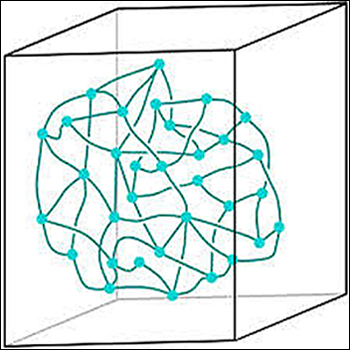
The beginning of Loop Quantum Gravity is usually tracked back to 1986, when Abhay Ashtekar, Professor at Penn State University, developed a quantum formulation of Einstein's General Relativity field equations. In 1988, physicists Lee Smolin and Carlo Rovelli extended the line of work and in 1990 showed that gravity is quantized using this approach. In other words, quantum physics and gravity were united into one theory without extra dimensions, etc. as in String Theory - a major breakthrough.
Loop Quantum Gravity (LQG) suggests spacetime is a series of tiny units that are connected to each other. Visualize these nodes of spacetime as incredibly small units about 10^-35 meters in size that can not be further divided and are connected to each other by fine lines. See the illustration at the left. Therefore, spacetime as we know it is a humongous network of tiny quantum nodes all inter-connected. The smooth spacetime framework in general relativity is what you see when you "zoom out" from the quantum scale up to the much larger human scale. The mathematics and physics involved in this theory are extremely complex.
LQG allowed scientists to calculate the entropy of a black hole because there are no infinities involved. This is generally viewed as the greatest technical success of the theory because LQG yielded results that matched the predictions of black hole entropy made by Stephen Hawking and others many years earlier in the 1970s. Perhaps the most famous use of LQG is with respect to the Big Bounce Theory. See the next section. Top
The Big Bounce Theory

According to the LQG Big Bounce Theory, the current universe resulted from the collapse of a previous universe. The Theory says that the pre-existing universe collapsed under the immense attractive force of gravity. As the pre-existing universe's volume and density approached the minute Planck scale limit, gravity switched from being attractive to being repulsive. This resulted in a brand new universe being formed. See the illustration at the left. The new universe immediately started to rapidly expand which we now call "inflation". Cosmologists refer to this overall process as the Big Bounce.
Over the lifetime of many billions of light years, this process is repeated over and over again. While this theory is an excellent theory that could explain what happened before the Big Bang, a possible flaw is the fact that a universe first expands and then gravity takes over and it contracts into a Big Crunch.
In the last 15 years or so, it has been discovered and confirmed that our universe is now expanding at an accelerating pace. The logical conclusion is that if the expansion continues to accelerate (as is now the case), the end point will be a Big Rip, not a Big Crunch and another acceleration. However..., we do not understand very much about "Dark Energy", the force that is propelling the current acceleration. Therefore, it is not a "given" that the current universe will end in a Big RIP. (See The End page.) Our theory about the end of our universe will probably change quite a bit when we understand Dark Energy much better. Top
Author's Comments
All of the above proposed scenarios, while extremely interesting, are just theoretical speculation. Unfortunately, there is no evidence for the Big Bounce, Multiverses, Quantum Emergence or a supreme being we call God. Even if multiple universes, etc. do exist, that only pushes back the question, "How did the multiverse itself get started in the first place?" While it is at times mind bending to speculate about time Before The Big Bang, we must not endorse as probable exotic mathematics and other interesting dreams about "what might have been".